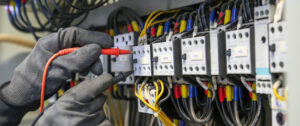The purpose of electrical wiring is to carry electricity throughout your home. Aside from this, it also serves as a method of grounding and polarization. Moreover, there are some requirements to be met when you plan to rewire your home. Contact Sharp Electric to learn more.

Most electrical appliances and lights have a grounding wire. This wire serves a few purposes. For instance, it provides a path for electricity to safely return to the ground. It also helps to minimize the likelihood of an electric shock.
The best way to know if your appliance has a grounding wire is to look at the plug. Normally, you’ll see three prongs on the plug. You may also notice a U-shaped slot.
Aside from providing solid electrical ground, a grounding system also makes sure that the correct amount of power is distributed throughout the home. Electrical appliances can get damaged or destroyed if not grounded correctly. Even a small surge of power can do serious damage, including burning the nerves and causing a fire.
To make matters worse, a surge of power can even be passed through conductive surfaces. When this happens, you could be sucked into a coma or suffer electrocution.
An electrical circuit is made up of two wires: the active wire and the neutral wire. The active wire supplies current, while the neutral wire returns current to the breaker panel.
The best part about a grounding system is that it protects you from the hazards of high voltage. A short circuit in your household circuits will result in a tripped breaker. If this happens, the tripping breaker will shut off the flow of current.
In addition to protecting you, a properly bonded and grounded electric system will help to reduce the build-up of static electricity. And, if it is properly insulated, it should keep the temperature of your house cool in the summer and warm in the winter.
Fortunately, most appliances have a grounding wire, and it is not difficult to install. Just make sure it is properly sized and positioned.
Electrical polarization is the process by which the centers of the positive and negative charges on a charged object are displaced in opposite directions. This re-alignment of these centers produces a net charge in the direction of the corresponding electric field.
Electric polarization can be induced in a number of different ways. For example, a dielectric can be polarized by a direct application of an electric field. A magnetic object can also be polarized by the application of a magnetic field.
Some conductors are capable of polarization, but not all. In fact, most current-carrying wires are not.
An insulator, on the other hand, is unable to carry electric current. However, it does have high resistance. Therefore, it makes it difficult for electric charges to flow freely.
Another way to understand polarization is to understand the redistribution of electrons within atoms. When an object with a high concentration of protons is close to a low concentration of electrons, the electrons will be redistributed around the nucleus.
Using the right combination of chemical bonds and an external electric field, the atoms in this situation will undergo a significant change. That change will produce a net positive charge on one side of the atom. The opposite side of the atom will then be negatively charged.
Finally, a number of materials have permanently polarized molecules. Examples include diamond, mica, plastic, and ceramic. These materials can also polarize in an x and z direction, depending on the way the field is applied.
To summarize, polarization is a subtle and complex process. It requires an understanding of chemistry and the interaction of an electron cloud with a charged nucleus.
There are many articles out there about the subject of polarization, but they all fail to deliver a scientific explanation.